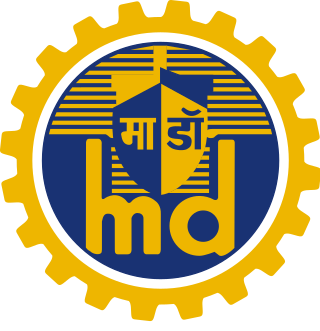
The Delhi-class destroyers, also known Project 15 are a class guided-missile destroyers of the Indian Navy. Three ships of this class are in active service. The Delhi-class vessels were the largest vessels to be built in India at the time of their commissioning. The ships were built by Mazagon Dock Limited (MDL) at a cost of ₹750 crore each.

INS Delhi is the lead ship of her class of guided-missile destroyers of the Indian Navy. She was built at the Mazagon Dock Limited in Mumbai and commissioned on 15 November 1997. This class is among the largest warships to be designed and built in India.

The Kolkata-class destroyers, also known Project 15A or Project 15 Alpha, are a class of stealth guided-missile destroyers constructed for the Indian Navy. The class comprises three ships – Kolkata, Kochi and Chennai, all of which were built by Mazagon Dock Limited (MDL) in India, and are the largest destroyers to be operated by the Indian Navy. Due to delays in construction and sea trials, the initial commissioning date of the first ship of the class was pushed back from 2010 to 2014.

The Brahmaputra-class frigates are guided-missile frigates of the Indian Navy, designed and built in India. They are an enhancement of the Godavari class, with a displacement of 3850 tons and a length of 126 metres (413 ft). Although of similar hull and dimension, internally, the Brahmaputra and Godavari classes have different configurations, armaments and capabilities. 3 ships of this class serve in the Indian Navy.

Sindhughosh-class submarines are Kilo-class diesel-electric submarines in active service with the Indian Navy. Their names are in Sanskrit, but in their Roman-alphabet forms sometimes a final short -a is dropped.

Mazagon Dock Shipbuilders Limited (MDL), formerly called Mazagon Dock Limited, is a company with shipyards situated in Mazagaon, Mumbai. It manufactures warships and submarines for the Indian Navy and offshore platforms and associated support vessels for offshore oil drilling. It also builds tankers, cargo bulk carriers, passenger ships and ferries.

INS Shishumar (S44) is the lead vessel of the Shishumar class of diesel-electric submarines of the Indian Navy. She was commissioned on 22 September 1986 under Commander P M Bhate.

The Nilgiri-class frigates, formally classified as the Project-17 Alpha frigates (P-17A), are a series of stealth guided-missile frigates currently being built by Mazagon Dock Shipbuilders (MDL) and Garden Reach Shipbuilders & Engineers (GRSE) for the Indian Navy (IN).
INS Shankush (S45) is a Shishumar-class diesel-electric submarine of the Indian Navy.

The Kalvari-class submarines, formally classified as the Project-75 submarines (P-75), is a class of diesel-electric attack submarines operated by the Indian Navy (IN). Built by a syndicate of French and Indian shipyards, namely, Naval Group and Mazagon Dock Limited (MDL) respectively, the class is an export derivative of the French-origin Scorpène-class submarine, originally designed by Naval Group.

The Visakhapatnam-class destroyers, also classified as the P-15 Bravo class, or simply P-15B, is a class of guided-missile destroyers currently being built for the Indian Navy. The Visakhapatnam class is an upgraded derivative of its predecessor, the Kolkata class, with improved features of stealth, automation and ordnance.

Project-75 (India), simply referred to as the P-75(I) program, is a military acquisition initiative affiliated to India's Ministry of Defence (MoD), aimed at the planned procurement of diesel-electric submarines for the Indian Navy (IN). Originally conceived in 1997, the initiative's objective has been to procure a class of six conventionally-powered attack submarines for the Indian Navy Submarine Arm, as a replacement for the force's Sindhughosh-class submarines.

INS Khanderi (S22) is the second of the Indian Navy's six Kalvari-class submarines being built in India. It is a diesel-electric attack submarine which was designed by French naval defence and energy company DCNS and manufactured at Mazagon Dock Limited in Mumbai.

INS Karanj (S23) is the third submarine of the first batch of six Kalvari-class submarines for the Indian Navy. It is a diesel-electric attack submarine based on the Scorpène class, designed by French naval defence and energy group DCNS and manufactured by Mazagon Dock Limited, an Indian shipyard in Mumbai. The submarine was launched on 31 January 2018, delivered to Indian Navy on 15 February 2021, commissioned on 10 March 2021 in Mumbai in presence of Chief of Naval Staff Admiral Karambir Singh and Admiral VS Shekhawat (retd.).

INS Vela (S24) is the fourth submarine of the first batch of six Kalvari-class submarines for the Indian Navy. It is a diesel-electric attack submarine based on the Scorpène class, designed by French naval defence and energy group DCNS and manufactured by Mazagon Dock Limited, an Indian shipyard in Mumbai. The first cutting of steel for the submarine began on 14 July 2009, and the ship was launched on 6 May 2019.

INS Vagir (S25) is the fifth submarine of the first batch of six Kalvari-class submarines for the Indian Navy. It is a diesel-electric attack submarine based on the Scorpène class, designed by French naval defence and energy group Naval Group and manufactured by Mazagon Dock Limited, an Indian shipyard in Mumbai, Maharashtra.

INS Surat is the fourth ship of the Visakhapatnam-class stealth guided-missile destroyers of the Indian Navy. The ship is the last of the line of destroyers built under Project 15 which includes the Delhi-class (P-15), the Kolkata-class (P-15A) and the Visakhapatnam-class destroyer (P-15B). The commissioning commanding officer of Surat is Captain Sandeep Shourie.

INS Vagsheer (S26) is the sixth submarine of the first batch of six Kalvari-class submarines for the Indian Navy. It is a diesel-electric attack submarine based on the Scorpène class, designed by French naval defence and energy group Naval Group and manufactured by Mazagon Dock Limited, an Indian shipyard in Mumbai, Maharashtra. The commissioning commanding officer of Vagsheer is Commander Vineet Sharma.

INS Mahendragiri is a Nilgiri-class frigate of the Indian Navy. It was built at Mazagon Dock Shipbuilders Limited (MDL) in Mumbai and was formally launched by Sudesh Dhankhar, wife of Vice-President of India Jagdeep Dhankhar on 1 September 2023.



















